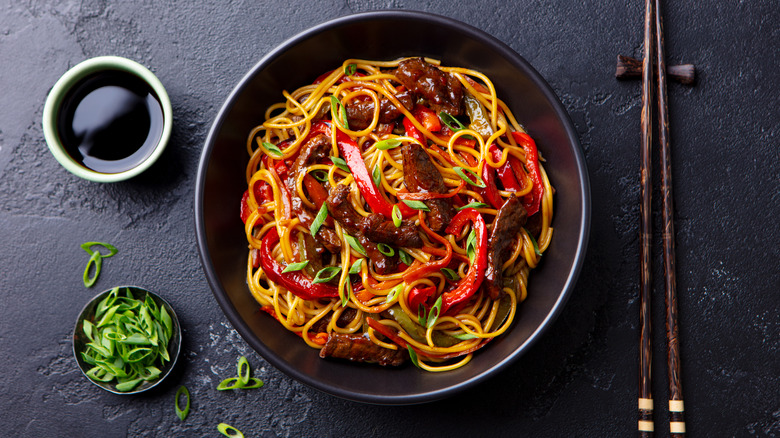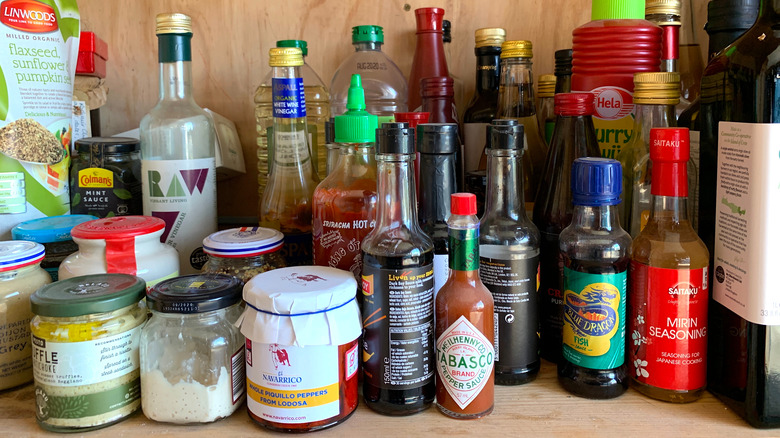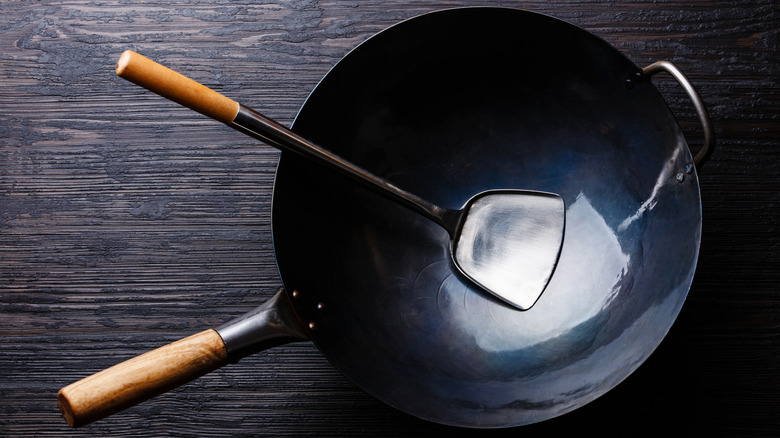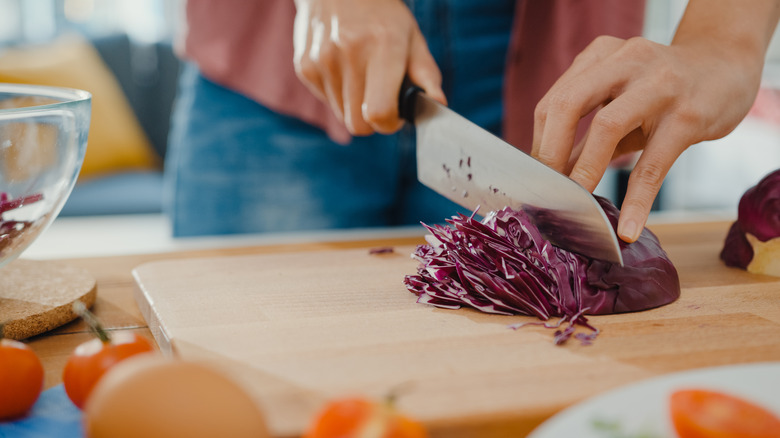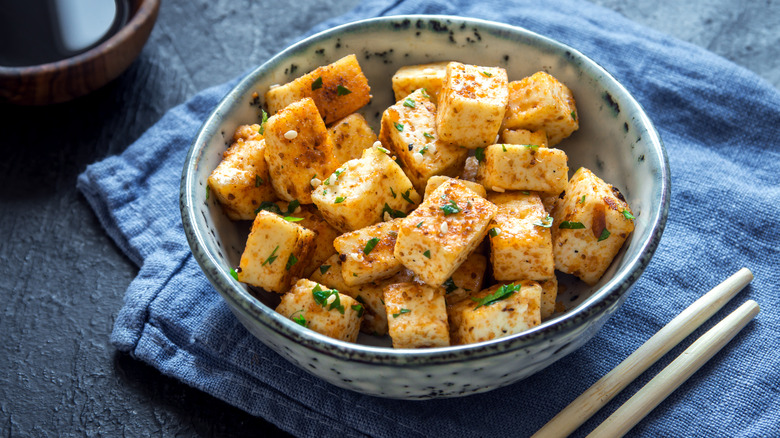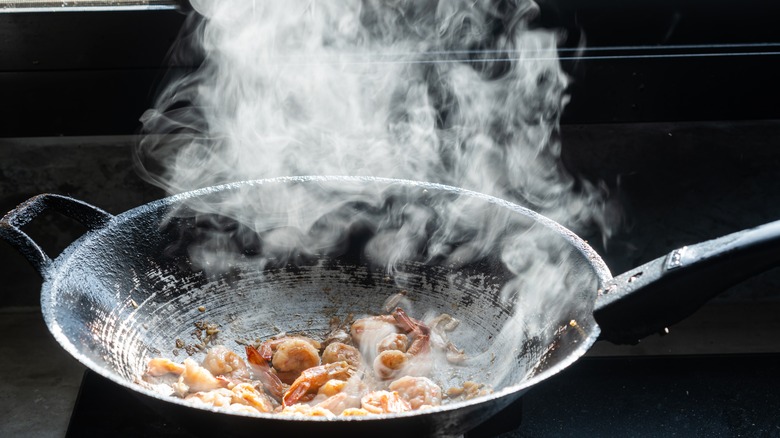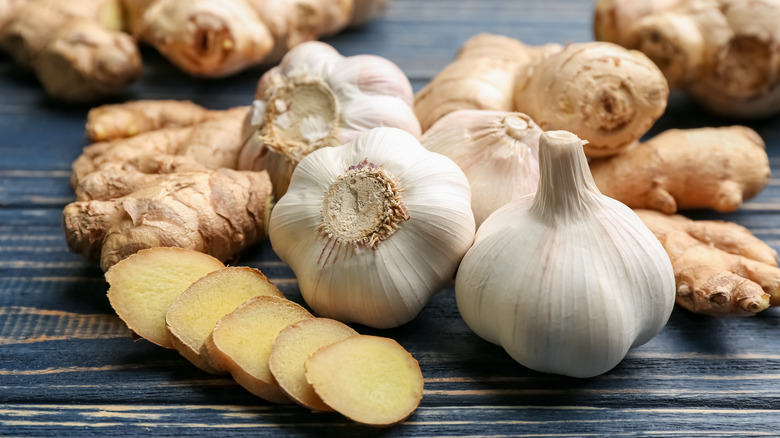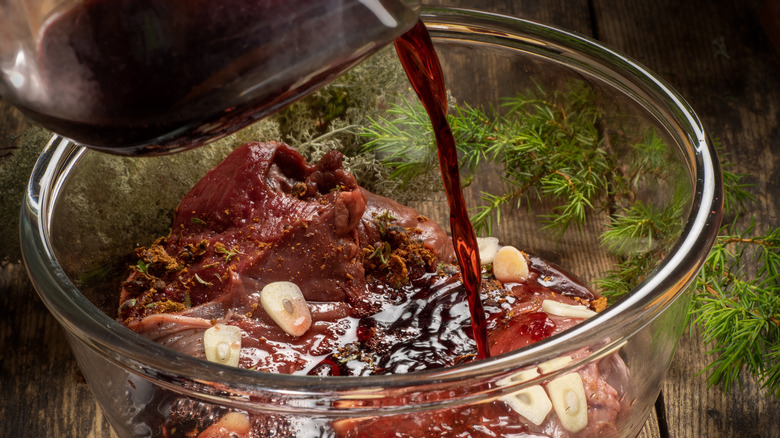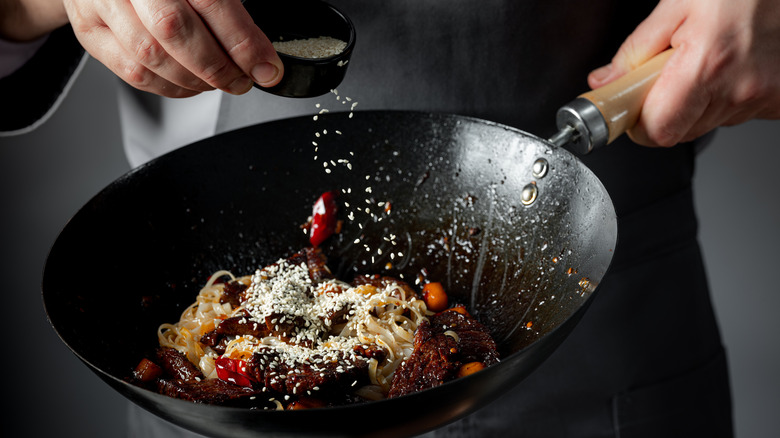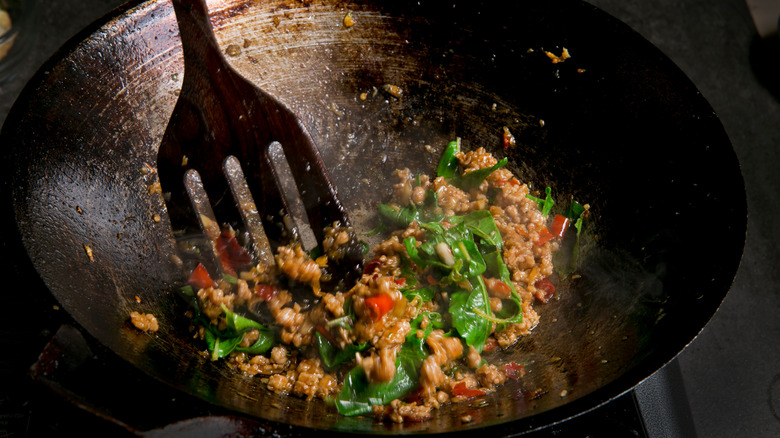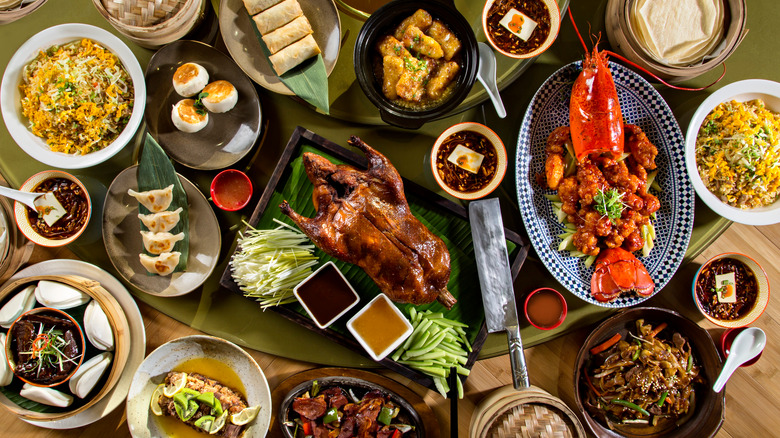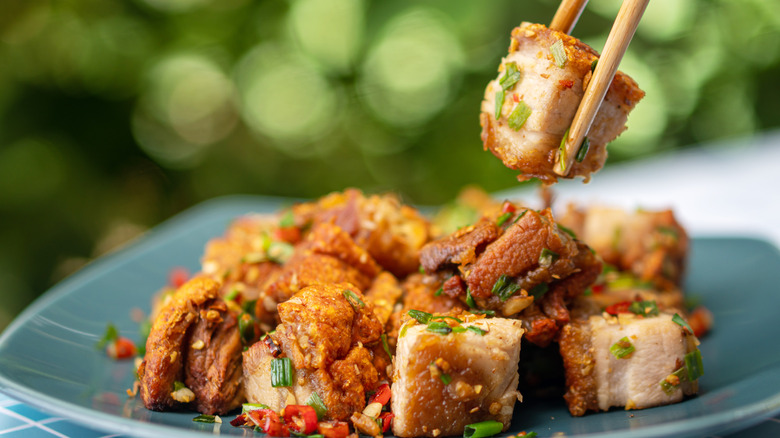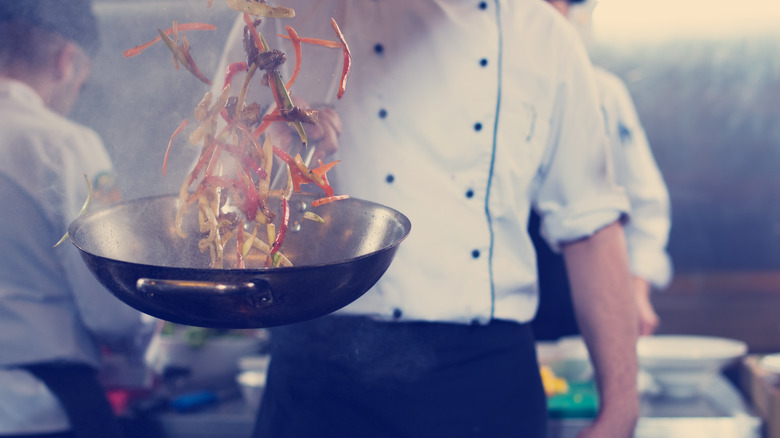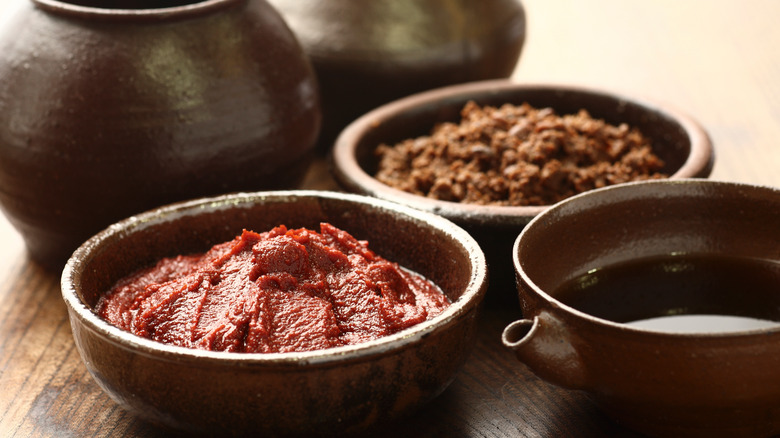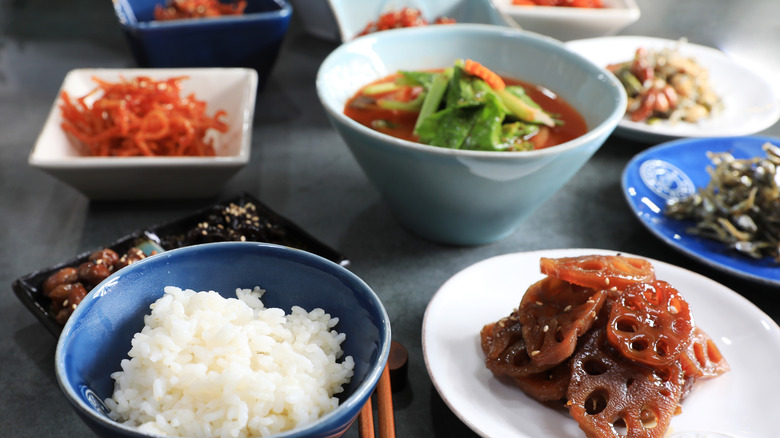15 Tips You Need For The Perfect Stir Fry
We may receive a commission on purchases made from links.
There's nothing quite like mastering a restaurant dish at home to make you feel like you've just unlocked a well-kept secret — a stir-fry is no exception. Stir-frying is the perfect back-pocket skill to ensure a delicious and healthy dinner awaits you on a busy weekday. Woks are originally from China and are estimated to have been in use for up to 3,000 years. Today, home cooks from around the world can enjoy all the benefits wok cooking can provide, including (but not limited to) a quick and tasty stir-fry, even when time and resources are short. Maybe it's time to start thinking of a homemade stir-fry as the original fast food!
Contrary to some misconceptions about Chinese cuisine, stir-fries from a wide range of Chinese and other Asian cultures are not only quick and easy to make, they can be incredibly healthy, relying on little oil and retaining the majority of the ingredients' nutrition and vitamins due to minimal cooking (via Healthline). However, because stir-fries happen in a flash, it is important to approach this kind of cooking with a sense of preparedness and thought to achieve great results. We can help! Here are some top tips on all things stir-fry from tools to techniques, helping you to achieve the perfect stir-fry.
Create a go-to stir-fry ingredients pantry
Cuisines from across the continent of Asia can vary vastly across regions and households. There are some wonderful base flavors and ingredients, however, that are well worth the investment to add depth to any stir-fry. Many of these base ingredients, like soy sauce, will also be non-perishable and happy to sit in a cupboard for months (or years) until needed.
Pantry ingredients like light and dark soy sauce (or tamari for a gluten-free option) are a great place to start. Other pantry items that will come in handy when cooking recipes across Asian cuisines could include oyster sauce, Shaoxing wine, toasted sesame oil, rice vinegar, and fish sauce. To add a spicy element, a Korean chile paste called gochujang makes a wonderful addition to many dishes — not just stir-fry. The options are seemingly endless!
While many grocery stores will carry a selection of these ingredients, you can browse for deals on Asian ingredients from Amazon, or, even better, a trip to Asian foods supermarket like H-Mart is highly recommended. While you're there, load up on jasmine or basmati rice and plenty of noodles, such as soba, ramen, or rice noodles, for experimenting. As with lots of quick-to-cook techniques like stir-fry, preparation is the secret that makes the dish taste better and minimizes stress in the kitchen. That preparation starts with the pantry.
Invest in a few pieces of equipment
Whether you are just beginning your cooking journey into stir-frys, or further down the path, investing in a few pieces of equipment will take you from your first to your 100th. For essential tools for cooking a stir-fry, you will simply need a wok, possibly a lid, and a rounded wok spatula to help scrape off every last bit of food from the wok's rounded sides.
Some tools, like a carbon steel wok, will only get better with time — if well looked after. A wok needs to be seasoned, a process using oil and high heat to create a protective non-stick layer to reduce food's likeliness to stick and burn. Do make sure you are using a wok that is suited for the type of heat you cook with, whether it's gas, electric, or induction. If using an electric stove, a flat-bottomed wok is recommended for even cooking. Depending on how else you use your wok, a bamboo steamer comes in handy when wanting to use the gentle technique of cooking food like dim sum, vegetables, or delicate whole fish.
Organize everything before you start cooking
As chef Jeremy Pang says in Lakeland Blog, when it comes to cooking great Chinese food, it's about "90% preparation and only 10% actual cooking." This is true to an extent when cooking from many cuisines: the French call this "mise en plase," meaning establishment or putting in place. Given the quick nature of stir-frying and the high heat needed to make it taste good, organization is exceptionally key for this cooking form.
All attention should be on the wok once the cooking begins, rather than quickly chopping up a forgotten item or scouring the cupboard for a sauce, unless of course, you like the taste of burnt food. It also means clearing the area around your cooking space, to ensure you are taking safety into consideration, especially when working with high heat. Most stir fry recipes, like our Orange Chicken Stir-fry rightly suggest prepping all ingredients including vegetables, proteins, and sauces first before moving over to the stove to cook.
Uniform-sized pieces are essential to good wok cooking
Stir-fries are more than the sum of their parts. They are an incredibly quick and effective way to showcase a masterful understanding of how to use hot-and-fast direct heat to achieve tender meats, crisp-yet-succulent vegetables, and a bright and flavorful sauce, seasoning, or marinade. The success of a stir-fry is a direct result of the size of its ingredients. This means ensuring all ingredients have been cut into manageable and equal-sized pieces, aligned with the time it takes for them to cook. However, equal-sized pieces doesn't necessarily mean one size fits all.
Slicing meats and prepping harder vegetables like carrots in thinner, same-sized pieces will ensure they cook consistently through during their short time in the wok. And, keeping quicker-cook items like bean sprouts or sugar snap peas whole will also help to prevent them from going mushy. Making each ingredient uniform according to its type will help prevent over or undercooking and produce a delicious stir-fry that comes together for the perfect bite.
Use an oil with a high-smoking point
There are an abundance of cooking oils available these days, making it all the more challenging to decipher what is best to use. Selecting refined light olive oils, like Bertolli Extra Light, work well for wok cooking as they naturally have a higher smoking point, or burning point, than extra virgin olive oil or butter. A higher-smoke point reduces the chance of burning the oil, resulting in bitter-tasting food. Do be aware that no matter what oil you're choosing, if you save and reuse your cooking oil — a common thing in the kitchen, especially when deep frying — the smoke point does lower with each use and increases the likelihood of releasing harmful chemicals like acrolein in the process.
When it comes to stir-frying, there are a number of high-smoking point oils, including refined avocado oil for sautéing, which has additional nutritional benefits like being a source of vitamin E. Safflower oil and rice bran oil also have high smoking points and a neutral flavor. Unrefined sesame oil, though commonly used in Chinese and other Asian cuisines for its rich flavor, is best saved as a finishing oil rather than one to cook with.
Don't be afraid to get smoking hot!
Despite the real concern of knowing your cooking oil's smoke point, one of the key elements to good wok cooking is its use of high heat to create a smoky finish and leave meats succulent and vegetables crisp. The high-heat, flash cooking is one of the reasons why Chinese take-out can taste so good! Professional kitchens use high-pressure wok burners to create a blast of heat and a memorable caramelized, smoky finish to their dishes.
In order to replicate the similar results at home it requires a bit of planning (like tying your hair back and clearing the area around where you're cooking) and a bit of bravery to work with and master high heat. Begin by placing your wok on the stove over a high heat — gas is ideal, but electric and induction work, too. Once the pan smoking hot, add 1-2 teaspoons of oil to coat the surface of your wok, allowing it to heat up until it begins to just smoke. This is your cue to begin stir frying! Professional chefs Andrew Zimmern and Ken Hom note one of the biggest mistakes you can make with your wok when stir-frying, is not working with very high heat for the entire duration — so make sure your ingredients sizzle when they first enter the pan.
Use aromatics
Every culture has it —base ingredients that make up the foundations of a cuisine. It's called a sofrito in Italian bases and classic French aromatics are called mirepoix, but each includes a mixture of carrots, onions, and celery. The vegetable "holy trinity" for gumbo in Cajan cuisine: onions, bell peppers, and celery.
Journalist and podcast host Clarissa Wei notes the aromatics of garlic, ginger, and scallions make up the backbone to many Chinese stir-fries — some of the ingredients often present within the Chinese herbal medicines. Like with other "holy trinity" aromatics, Wei says these ingredients tend to be used towards the beginning of a stir fry or braising dish, releasing the fragrances into the cooking oil and infusing flavor into vegetables, proteins, and sauces. This is often referred to as a "blooming" technique of South Asian cooking and involves sautéing whole spices or aromatics in fats to create intense and distinctive flavors.
Marinate your protein
Marinating your stir-fry protein, no matter what you are using, is a way to add depth, brightness, and tenderness to each mouthful. While this doesn't need to be done 24-hours in advance — especially when using thin cuts slices of meat — a brief soak in a marinade or a spice rub is absolutely worth it to help recreate that professional flavor profile. For example, Vietnamese Shaking Beef recipe requires marinating the meat for no more than an hour for a great stir-fry. Marinate tofu by pressing it first (if water-packed), then soaking in your marinade for up to an hour before cooking (via Nora Cooks).
For animal proteins like chicken and beef, you can also use a Chinese marinating technique called "velveting" to achieve a texture much like the name would suggest: tender, luxurious, and satisfying. Begin by thinly slicing your protein, then marinating for about 30 minutes in a mixture of egg whites, corn starch, sesame oil or mirin (rice wine), and salt or soy sauce. You can then blanch the strips in hot oil or water and set aside ready to be added to your stir-fry.
Order your ingredients for perfectly timed cooking
A great stir-fry is the result of a well-timed execution, resulting in meats that are tender, and cooked but crisp vegetables. The secret to achieving the perfect timing for each ingredient is understanding the order in which each ingredient goes into the wok. There are some basic rules of thumb that will apply to most stir-fries: First, the oil goes into the hot wok or pan until just smoking and followed quickly by aromatics, then proteins like meat. Next, add harder vegetables like carrots or broccoli (if not pre-blanched), then softer vegetables like bok choy or choi sum, then finally a sauce.
Chef and cookbook author Jeremy Pang lays out this order in his first cookbook, "Chinese Unchopped, An Introduction to Chinese cooking," suggesting home cooks build what he calls a "wok clock," or a strategy of ordering ingredients around a plate to be used clockwise, that works to reduce kitchen confusion and guarantee a great tasting result.
Don't overcrowd your wok!
Not overcrowding your wok is the number one rule from many wok chefs. The 2010 MasterChef winner Adam Liaw encourages home cooks to take into account the amount of moisture that will release from the ingredients by leaving room in a pan or wok because overcrowding will most likely stew your dish rather than stir-fry (via SBS).
The amount of excess moisture created from a wok that's overflowing with ingredients reduces the effect and results of the cooking technique, basically taking you from a stir-fry to a stir boil or stir steam. Not only will the texture be disappointing, it can also impact the flavor and leave your tastebuds totally underwhelmed, according to Fryingpro.com. And while woks do make great tools for both steaming, braising, and stewing (as well as even baking!), in order for the results to meet expectations, each technique should be done with intention.
Consider the five flavors to create balance
Chinese cuisine, much like many different Asian cuisines, relies on a balance of flavors to excite and engage the palate. We recognize these as tasting notes throughout many cuisines, helping us understanding how the flavors hit our tongue and what winning combinations leave us wanting more, like sweet and sour or umami, according to the Escoffier School of Culinary Arts.
The five flavors used to create balance in Chinese cuisine are sweet, sour, salty, spicy, and bitter, though the emphasis of each flavor may vary from region to region (via China Highlights). For instance, spiciness is a more pronounced flavor in cuisine of the Sichuan and Hunan regions of China, while sweeter flavors are more present in Cantonese cooking like that of Hong Kong. When cooking a dish that focuses more intensely on one of these flavors, it helps to balance the meal with other dishes or condiments that highlight elements that complement. It's also no coincidence that there are also five key components to Chinese five-spice powder.
Vary your textures
While flavor plays an important part in overall satisfaction and success of a dish, texture is also a key, if not often overlooked, element. Soft textures, for instance, often evoke a sense of comfort and healing, and can used to help when someone is feeling under the weather or in need of extra care. In order to keep our palates interested, using a variety of textures in a stir-fry can add to an overall feeling of satisfaction after a meal. Texture plays its own important role in Chinese and other Asian cuisines, with some foods like jellyfish or sea cucumber, eaten mostly in appreciation of their wobbly texture, as noted by Fuchsia Dunlop.
Chef Jeremy Pang says, "Chinese food is all about achieving a balance of flavor, texture, and color – whether you are serving one plate or several plates of food" (via Independent.ie). Thinking about the perfect bite of a Peking duck, with the soft and succulent duck, crisp and hydrating cucumber, pickles with sour crunch, silky hoisin sauce, and flaky, dry pancake —it's easy to see how texture plays a key element towards overall satisfaction.
Keep it moving to circulate heat
Mastering the heat required to make a delicious stir fry is both an art and a science. If you're Cantonese, you may be familiar with the term wok hei to describe this specific mixture of chemistry-meets-artistic-flare. According to Michelin, the literal translation is "breath of a wok," alluding to the various ways there are to circulate heat while stir-frying without losing the key element of high heat, essential for that wok-kissed smoky flavor. The science part of wok hei comes from the chemical reaction that occurs when the sugars in the ingredients caramelize under the intense heat, the oil smokes, and a Maillard reaction —a blending of the seared proteins and sugar caramelization —occurs.
In order for this it is important to keep the temperature consistent inside the wok, including a few restrained wok tosses or folds, depending on the type of wok you're using. During his cooking demonstration, chef Cher from the London-based School of Wok showcases several of these techniques to make an Indonesian and Malaysian-inspired Spicy Curry Noodle dish. By using quick and controlled wok tosses and folds, using his spatula and the air to circulate heat, he is able prevent the individual ingredients from burning without reducing the heat inside the wok.
Get saucy!
Once you've achieved those smoky aromatic flavors, tender meat or crispy tofu, and the perfectly cooked vegetables, there's only one thing left to do: get saucy! When making a good stir-fry most sauces are added at the very end of the cooking process, sometimes thickened with a bit of cornstarch slurry (cornstarch and water) that wraps around and coats the individual ingredients. This works to create a moist dish and a glossy finish, without leaving it feeling too soggy, greasy, or runny.
Sauces can be an easy way to add variety to what essentially could be the same wokful of ingredients! You can also use a sauce to explore different cuisines and regions. Try a cornstarch-free Japanese-leaning teriyaki sauce, or tare sauce, traditionally used for dipping. A Thai beef and vegetable stir-fry recipe uses the quintessential Thai ingredients like of fish sauce and fresh herbs, or a classic Chinese black bean sauce recipe creates a full-flavor dish.
Accompaniments will enhance your stir-fry
Embracing multiple dishes and family-style sharing helps to create a balance of the key five flavors. You can include rice like jasmine, either fried or steamed, or wheat noodles of a variety of textures, to soak up any excess sauces and creating a satisfying balance. Sichuan-style fermented condiments and pickles are also welcomed on the table for gut health and help to add vibrancy and variation to a meal. Many of these kinds of condiments or pickles can either be bought or be made in advance and stored in the cupboard or fridge.
For more of a banquet-style meal, start with a tongue-tinging hot and sour soup to wake up the taste buds and excite the palate before moving onto a stir-fry and a few other accompanying dishes. Consider protein-based sides, such as tea eggs or char siu roasted pork, to accompany a stir-fry, especially if it's vegetable-based.
